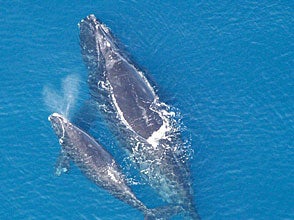Doing Right by Right Whales
Distinct "v-shaped" spout patterns spray a dozen feet into the crisp ocean air -- a sure sign that right whales have returned to calve off the coasts of Florida and Georgia. The few remaining whales come each spring, sometimes swimming close enough to spot from shore.

Distinct "v-shaped" spout patterns spray a dozen feet into the crisp ocean air — a sure sign that right whales have returned to calve off the coasts of Florida and Georgia. The few remaining whales come each spring, sometimes swimming close enough to spot from shore.
Scientists estimate that only 300 to 400 of these whales remain. Although listed as endangered in 1973, the North Atlantic population of right whales has made little progress towards recovery. In 2004, the National Marine Fisheries Service wrote that the "loss of even a single individual right whale may contribute to the extinction of the species."
The right whales’ very name suggests why they were hunted to the brink of extinction. Whalers in the 18th century thought of them as the "right" whales to hunt. They were easy to spot from shore, floated to the surface when killed and provided a bounty of oil and meat.
Today, although no longer hunted, right whales are still victims of human activity. Because their calving grounds and habitat stretch through some of the busiest shipping channels and fishing spots in the world, right whales are often struck by passing ships or become entangled in fishing gear. And now, despite the obvious threat facing right whales and their potential extinction, the U.S. Navy is planning to construct a 660-square mile undersea warfare training range close to the only known calving grounds for right whales.
The warfare training grounds would include a system of approximately 300 underwater "sonar nodes" connected by cable to a landside facility some 50 nautical miles away. When fully operational, the facility will run continuously throughout the year with 470 planned warfare training exercises that involve submarines, high-speed surface ships and aircraft. The warfare training area may also impact other endangered species, including sperm whales, leatherback sea turtles, Kemp’s Ridley sea turtles, blue whales, fin whales, loggerhead turtles and green sea turtles. Simply put, the Navy approved its plan without a full scientific analysis of the impact warfare training will have on right whale calving grounds. Earthjustice has been closely following the planning process, pointing out the Navy’s flawed logic and illegal approach in public comments.
Unfortunately, despite warnings from its own scientists, the National Oceanic and Atmospheric Administration — the parent agency of NMFS — offered approval of the Navy training grounds in July 2009. Dr. Jane Lubchenco, an environmental scientist and current administrator of NOAA, has repeatedly said her agency is committed to relying on science in its decision making. But for the preservation and protection of right whales, her agency seems to be strangely inattentive to the science. The science is clear on right whale preservation: "The loss of even a single individual right whale may contribute to the extinction of the species."
Earthjustice will continue to follow these developments and is fighting for strong protections for right whales and other endangered species.